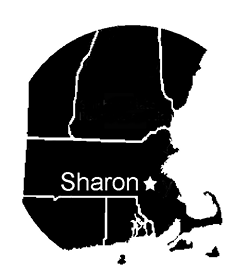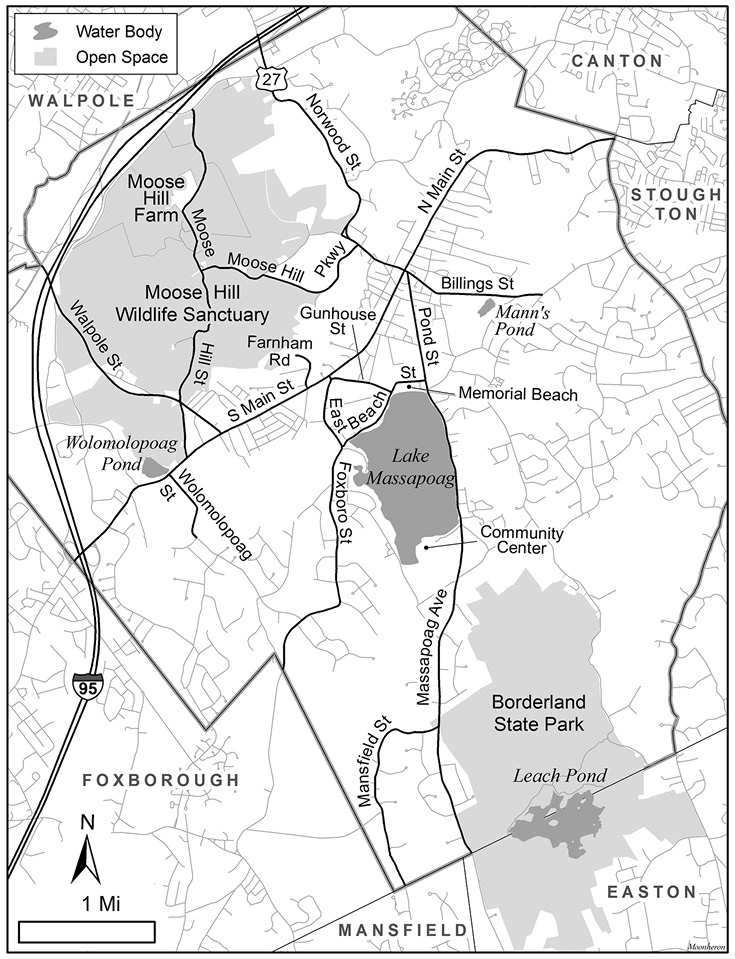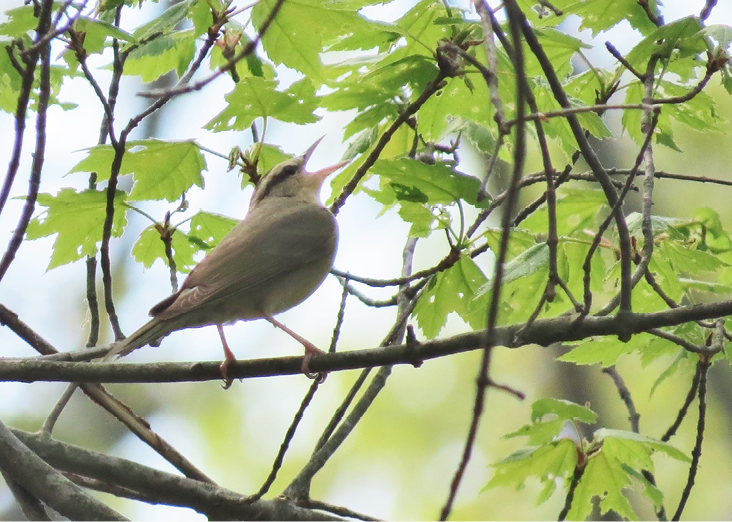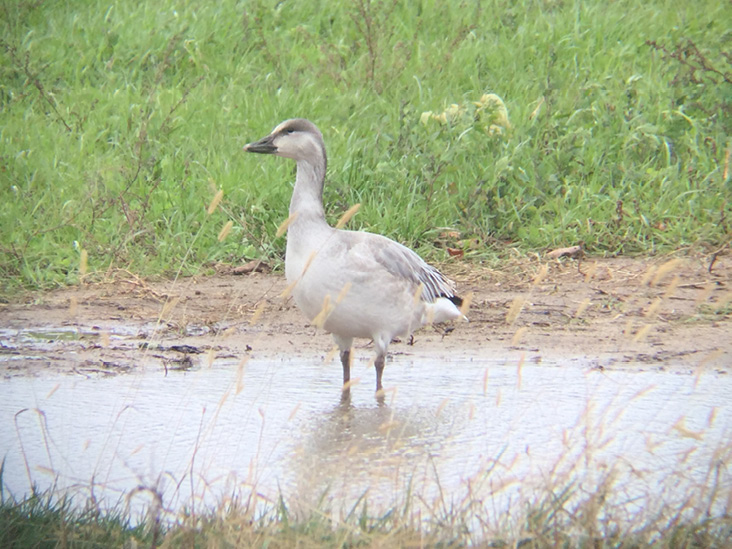Liam Waters
 About halfway between Boston and Providence and easily accessible by either Interstate 95 (I-95) or the Massachusetts Bay Transportation Authority Commuter Rail Providence/Stoughton line, lies the town of Sharon. From the 1800s until the 1940s, Sharon was a summer resort town where people came to stay at inns and hotels around Lake Massapoag. The town's current community center, located on a hill overlooking the south end of the lake, is a restored hotel that was acquired by the town in 1967.
About halfway between Boston and Providence and easily accessible by either Interstate 95 (I-95) or the Massachusetts Bay Transportation Authority Commuter Rail Providence/Stoughton line, lies the town of Sharon. From the 1800s until the 1940s, Sharon was a summer resort town where people came to stay at inns and hotels around Lake Massapoag. The town's current community center, located on a hill overlooking the south end of the lake, is a restored hotel that was acquired by the town in 1967.
There is a rich Native American history to the area, and there are a few sites in Sharon that have solar and lunar significance. The Wampanoags hunted and fished in the area for hundreds of years before British settlers came in 1637. Sharon was established as the 2nd Precinct of Stoughton in 1740. It was incorporated as the Town of Stoughtonham in 1765 and named Sharon in 1783. During the American Revolution, the townspeople—mostly farmers and craftsmen—made cannonballs for the Continental Army, and you can still find iron smelts in parts of the town today.
This article provides a season-by-season guide to birding the town of Sharon. Depending on how adventurous you feel and the time of year, you can spend either a solid half or full day birding. Moose Hill is one of the town's prime birding locations, but it can be confusing to people not familiar with the area, so an explanation is in order.

Fig. 1. Map of Sharon, Massachusetts.
The Moose Hill complex
There are two conservation properties on Moose Hill, owned by separate organizations; they are contiguous and share a couple of trails. Mass Audubon's Moose Hill Wildlife Sanctuary is the organization's oldest sanctuary and encompasses 1,971 acres of forest, wetlands, and fields. The sanctuary's Farm at Moose Hill is a Community Supported Agriculture Program (CSA) in partnership with Ward's Berry Farm; the CSA farm fields are near the Ward's Farm fields. A good map of Mass Audubon's Moose Hill Wildlife Sanctuary can be found here: https://www.massaudubon.org/content/download/8080/145429/file/moosehill_trails_2015.pdf
Moose Hill Farm, a 347-acre property owned by The Trustees of Reservations, is a former "gentleman's farm" located on the north side of Moose Hill along Moose Hill Street, with trails through forest and open fields. Instead of crop farming, the Trustees have started a meat CSA, raising and pasturing beef cattle in their fields. A map of The Trustees' Moose Hill Farm can be found here: http://www.thetrustees.org/assets/documents/places-to-visit/trailmaps/Moose-Hill-Farm-Trail-Map.pdf
Mid-winter to early spring
If it has been a snowy winter (it seems to me that Sharon gets more snow than most of southeastern Massachusetts) and Lake Massapoag is frozen, it can be tough birding in mid to late winter. If Lake Massapoag stays open, the geese flocks usually stick around and are always worth a check—Brant, Snow, Ross's, Greater White-fronted, Barnacle, and Cackling geese all have been seen in the last ten years. The best places to check for geese flocks are the Ward's fields and the adjacent Wolomolopoag Pond, the Moose Hill Wildlife Sanctuary's CSA fields, and Lake Massapoag (see map). If there is some open ground, these fields can host flocks of Horned Larks, with the occasional American Pipit, Snow Bunting, or Lapland Longspur. American Tree Sparrows are uncommon locally but can be found along the brushy edges of these fields. They seem partial to the power line cut that runs from Furnace Street to Pine Street and along Gavin's Pond and Wolomolopoag Pond (best accessed from either Furnace Street or South Main Street).
As March comes around, duck numbers start to increase. Leach Pond at Borderland State Park, which is in both Sharon and Easton, can have good numbers of Ring-necked Ducks and Common Goldeneyes; it is the best spot around for whatever dabbling ducks might be in the area. There is usually a raft of Common Mergansers on Lake Massapoag; sometimes they are at the nearby, much smaller Mann's Pond on Billings Street where you can get much better views. Massapoag is good for a variety of ducks that use the lake during the day, but the real draw for Massapoag is the dusk roost. There are a gull roost and a duck roost at Massapoag. The spring duck roost peaks in March, with Common Goldeneye (high of 85), Ring-necked Duck (185), Hooded Merganser (155), and Common Merganser (210) all peaking the second week of March. Bufflehead (70) has a less distinct peak during the last two weeks of March into the first week of April. This type of birding is not for everyone, but it can be rewarding. Patience and a large objective spotting scope are musts—as is a good sense of duck shapes.
It is nearly impossible to predict when it is going to be a good night for gulls at the roost, and numbers can fluctuate greatly from one night to the next. There also is no apparent pattern of when unusual gulls show up in the mix. Lesser Black-backed Gulls, especially, seem to appear for a night or two only to go missing and then reappear a couple nights later. The gulls (unsurprisingly) like to roost in the middle of the lake. This makes viewing them difficult and a spotting scope necessary. Depending on the wind direction, the gulls may be closer to either the south or north end, whichever is in the lee of the wind. Both ends of Lake Massapoag have easily accessible public viewing and parking. The parking lots for Memorial Beach on the north side often are not plowed in the winter, but the boat ramp on the north side is usually at least partially plowed. The viewing from the south end is from the community center, and that lot is always plowed. You can't view the roost from the parking lot there, but it is a short walk of 200 feet across a lawn that is usually windswept but may have some high snow drifts on occasion. The gull roost is predominantly Ring-billed Gulls and varying numbers of Herring Gulls. Great Black-backed Gulls are usually present in small numbers. Iceland, Glaucous, and Lesser Black-backed gulls are uncommon to rare.
Rusty Blackbirds typically can be found in late February through March along the mile-long Beaver Brook Trail that runs between Farnham Road and the Sharon commuter rail station. The Rustys are usually found in a spot that is closer to the Farnham Road entrance. Park outside the yellow gate on Farnham Road. Walk in past the gate and follow the road to the Beaver Brook trailhead, which is on the right side of the road beyond the stump dump, yard waste, and composting facility area. If you reach the pump house you have gone too far. Your best chance of having Rustys is along the first 0.2 mile of the trail into the woods. Listen for them calling or singing, and check for them perched on the tops of cedar trees in the swamp. Most of the trail is close to the brook. From the center of town, you can access the trail by driving to the south end of the outbound parking lot for the commuter rail and following the signs for the Beaver Brook Trail down the dirt road off the parking lot.
Starting in March, the large pasture field at The Trustees' Moose Hill Farm is a favored display ground for American Woodcocks. They also use the nearby power line cut that runs through Moose Hill and the old Poor Farm area of the Moose Hill Wildlife Sanctuary. You can easily access the power line from Moose Hill Street. Counts of five to ten are not uncommon depending on how much of the area you cover.
Spring Migration
Spring migration can be hit or miss locally. Sharon has so much good habitat that there isn't one good migrant trap to concentrate the birds. That said, we do have good spring mornings in town. Throughout May, there are guided walks of the Billings Farm Loop at Moose Hill Wildlife Sanctuary before work, usually starting at 6:00 on Tuesdays and Thursday mornings; check the South Shore Bird Club and Mass Audubon websites to confirm times and dates. This loop passes through varied habitats and has produced some rare birds including Olive-sided and Yellow-bellied flycatchers, Clay-colored Sparrow, and Mourning, Hooded, and Kentucky warblers. Louisiana Waterthrushes are uncommon around the Moose Hill complex where they show up in red maple swamps rather than near rushing water. No one trail is noticeably better than the others for getting good numbers and diversity of migrants, so pick a trail that suits your interests. Some of the more intriguing trails at the Moose Hill sanctuary are the Bluff Trail, the Kettle Trail, and the Pepperbush Trail; all will lead you through a range of habitats and often near streams, swamps, or other wet areas.

Worm-eating Warbler. All photographs by the author.
Breeding Season
One of highlights of the breeding season is the number of Worm-eating Warblers that breed at Moose Hill. They have expanded in the last five to ten years, going from only a few pairs to close to 30 pairs. They can now be found on most trails at Moose Hill, but the highest densities are along the Summit Trail, the Bluff Trail, and the Kettle Trail/Ovenbird Trail area, which is the original hotspot for this species. On the Trustees' property, the best trail for Worm-eating Warblers is the Woodland Trail. For the past couple of years, one pair has been relatively easy to get as a drive-by from Moose Hill Street just south of the power line crossing. I have not explored much of Borderland State Park, where there seems to be only a small population.
Moose Hill has one of the larger areas of undisturbed forest in Sharon, where numerous woodland birds breed. At least two pairs of Pileated Woodpeckers can be found, along with other forest birds such as Hermit and Wood thrushes, Brown Creeper, Eastern Wood-Pewee, Scarlet Tanager, Black-billed and Yellow-billed cuckoos, and Broad-winged Hawks. Blue-gray Gnatcatchers and Veerys are easily found in any of the red maple swamps in town, and Tree Swallows and Eastern Bluebirds nest in boxes in most of the fields.
The two main power line cuts in Sharon, the one that cuts through Moose Hill, and the one that goes from Furnace Street to Pine Street, have good populations of breeding shrubland birds such as Blue-winged and Prairie warblers, Field Sparrows, Eastern Towhees, and Indigo Buntings. Barred Owls are common nesters, and it is not uncommon to come across a family when walking one of the trails in late May. Eleven species of warbler breed in town with some regularity, highlighted by Northern Waterthrush, Black-and-white Warbler, American Redstart, and Black-throated Green, which unfortunately is declining rapidly as we lose the hemlocks to the woolly adelgid. Most of these warblers breed at Moose Hill; another good place for breeding warblers is the King Philip trails on town conservation land in the southern end of town. Access these trails from a small parking lot on Mansfield Street at 42.074279, -71.179982 across from 98 Mansfield Street. Yellow-throated Vireos breed around the ponds at Borderland State Park, and probably around the marsh at the Trustees' Moose Hill Farm as well, but that hasn't been confirmed yet. Savannah Sparrows breed in the large pasture field at Moose Hill Farm and also in small numbers in the sanctuary's CSA farm fields. Borderland State Park has not been carefully covered during the breeding season and could hold some interesting surprises.
Fall Migration
Fall migration starts in August with inland shorebirds and early warblers. If there hasn't been too much rain, Leach Pond at Borderland State Park can be great for shorebirds and ducks. It has looked like an absolutely perfect spot for a rare inland Little Blue Heron, and there are records of Glossy Ibis. Least Sandpipers and Killdeer are the most abundant shorebirds to frequent the flats, and there also have been Semipalmated Plovers, Semipalmated Sandpipers, Greater and Lesser yellowlegs, Spotted and Solitary sandpipers, and a single Pectoral Sandpiper. Viewing the shorebirds is difficult, since the only way to view them from Sharon is to bushwhack off the Pond Walk trail, and even then there's not an unobstructed vantage point.
The better viewing spots are from the Pond Walk trail on the Easton side (and therefore in Bristol County). The easiest access is from the trail as it passes along the small cove on the south side of Leach Pond. This cove is often one of the first places with exposed mud, and there is good, close viewing. The other option for viewing is from the woods along the edge of the hay fields around the farmhouse. There are two spots within these woods that offer a decent, if obscured view. One is from the east side of the pond near 42.065982, -71.149284. The woods here are sparse, and it is not difficult to walk through and find a gap in the trees. The other viewing point is near here 42.063603, -71.151607 but sometimes requires standing in some mud for a better view.
These Pond Walk trail vantage points in Easton are typically better than the cove in Sharon for viewing ducks, which tend to be in the middle of the pond. The best option is probably near 42.062971, -71.154341. The ducks arrive a little later than the shorebirds; mid-September to the end of November is the best time period. On a good day, the ducks include Northern Pintail, American Wigeon, Northern Shoveler, and both Green- and Blue-winged teal. This is also a staging pond for Wood Ducks, with high numbers present from mid-August to mid-October, with the peak of over 100 individuals in mid-September. The trails through the woods to these vantage points can be decent for fall warblers, so keep an eye out for movement.

Snow Goose.
As the last week in September rolls around, the focus for land birding turns to weedy areas. The best place for weeds is the Ward's fields off Wolomolopoag Street. The Farm at Moose Hill CSA fields (both upper and lower) have better public access but often get plowed under sooner. The best birding locations may shift from year to year but the general patterns hold true. The upper CSA field is usually the first to get plowed, so it is the first to get American Pipits. The weedy corner on the edge of the lower CSA field is a good spot where sparrows and the occasional warbler perch up.
The Ward's fields are a bit harder to bird but can be rewarding. It is possible to walk the fields, but you must be careful to stay out of the way of the workers and stick to the farm roads and paths. Do not walk through pre-harvest crops. The overgrown squash patches are one of the better places for Connecticut Warbler. The tomato patch and the weedy road edges are usually the best areas for sparrows, but they can be anywhere. Song and Savannah sparrows can be quite abundant in these fields, with smaller numbers of Swamp Sparrows and Bobolinks. Common Yellowthroat, Palm, Blackpoll, and Yellow-rumped warblers are regularly seen feeding in the weedy patches with the sparrows. Indigo Buntings can also be found, along with the occasional Dickcissel. Blue Grosbeaks and Lark Sparrows have been seen in the lower CSA field but not across the street at the Wards fields, probably due to lack of vegetative coverage.
There are two smaller weedy patches in town that are quite hit or miss for grassland birds. The Sharon Community Gardens at the corner of East Foxboro and Gunhouse streets is not usually a good spot, but occasionally it has been productive. The town stump dump, yard waste, and composting facility on Farnham Road (park outside the gate and walk in) is a small but good place for sparrows in the fall. It seems to be better than the other fields for White-crowned Sparrows and especially for Indigo Buntings, with counts of six to eight.
Late fall early winter
Starting the last week of September or the first week of October, gulls and ducks begin to roost at Lake Massapoag again, but the roosts don't have such distinct peaks in the fall as they do in March. Look for Canvasbacks or Redheads in October and November; they are seen sporadically, though probably are decreasing. Sea ducks are more prevalent in the fall than in early spring. Scoters and Long-tailed Ducks are most common from mid-October to mid-November. Buffleheads and Ring-necked Ducks peak the first week of November, and Hooded Mergansers peak around the first of December. Common Mergansers don't peak until mid-December. All three grebes—Red-necked, Horned, and Pied-billed—can be found on the lake from late September through early December.
This is also peak goose season. The goose flock at Ward's fields changes frequently. The best places to see the geese are in the Ward's fields off Wolomolopoag Street, at Wolomolopoag Pond, and at Lake Massapoag. At Lake Massapoag the geese tend to congregate at the cove on the west side, which is difficult to see because it's a far scope from the southeast corner. Sometimes you can see part of the flock from the end of Sturges Road, but you have to look through trees and someone's yard.
Amenities
Support local businesses. Angels Café is located right in the town center and is your typical coffee café. Ward's Berry Farm has a small store and café with a smoothie bar, sandwiches, and homemade zucchini bread. There are also various delis and Chinese and Indian restaurants in Sharon, most in the center of town (Pond Street and South Main Street) or at the Heights Plaza on South Main St just north of the Ward's Fields. For folks who need their Dunkin or Starbucks, both are located, along with a newly renovated Shaw's supermarket, at the Shaw's Plaza on South Main Street near I-95.
Additional information
http://www.sharonfoc.org/ Not always current, but has information on town-related conservation issues and trails. More information on the non-Moose Hill trails can also be found here.
http://southshorebirdclub.wixsite.com/ssbc
https://www.massaudubon.org/get-outdoors/wildlife-sanctuaries/moose-hill
http://www.thetrustees.org/places-to-visit/greater-boston/moose-hill-farm.html
Liam Waters has lived in Sharon for as long as he can remember. His birding interest was started at Moose Hill when he was eight, and Sharon remains one of his favored patches. He has done various bird surveys across the state, including point counts along the Moose Hill power lines and transect surveys of Stellwagen Bank National Marine Sanctuary. He will put his Sharon birding on hold for the next few years while he finishes a Bachelor of Science degree in Wildlife Ecology and Conservation at the University of Massachusetts Amherst, but he is looking forward to finding new patches near Amherst.